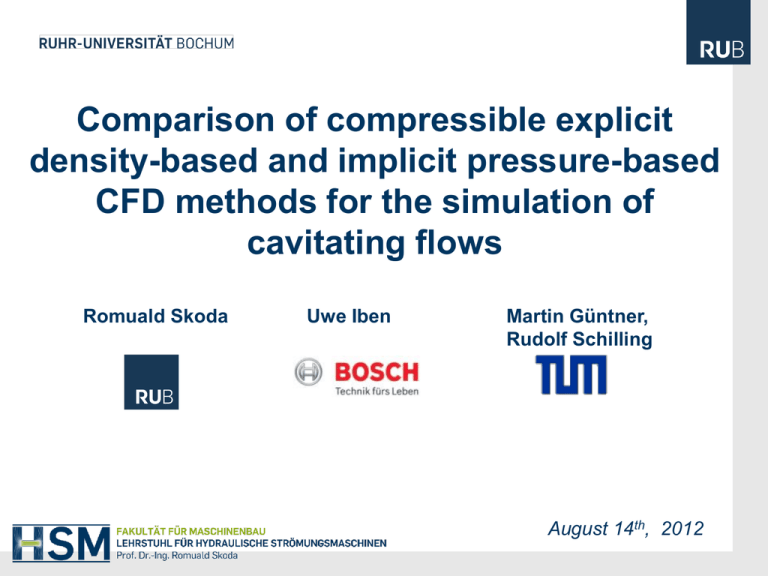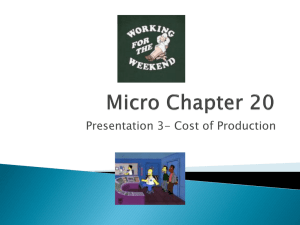149skoda
advertisement

Comparison of compressible explicit density-based and implicit pressure-based CFD methods for the simulation of cavitating flows Romuald Skoda Uwe Iben Martin Güntner, Rudolf Schilling August 14th, 2012 Motivation • Explict CFD methods resolve all relevant time scales of the wave dynamics (~ 1 nano sec). Cavitating flow in a micro channel Skoda, Iben, Morozov, Mihatsch, Schmidt, Adams: Warwick, UK, 2011 Liquid Volume fraction • Problem: Due to the coupling of spatial and temporal resolution (accoustic CFL condition) explicit methods generate prohibitely long computation times in complex geometries (injection systems, pumps, …) Pressure Distance of Wave travel at CFL = 1 The smallest cell in the domain dictates the overall time step • Is it really necessary to resolve all time scales? We would like to increase the time step systematically and therefore need an implicit method. Implicit pressure-based CFD methods for Cavitatiing Flows | Romuald Skoda | 14.08.2012 2 Numerical method and Physical model • To get an implict method we modify a compressible standard pressure-based algorithm (SIMPLE, 2. order in space and time) 1.) local underrelaxation (preconditioning of the matrix) 2.) density- instead of pressure correction, pressure from EOS • Reference method: Explicit density-based code with CATUM flux functions (TU Munich) and time integration scheme (2. order) • Homogenous model • Neglect of the energy equation and use of a barotropic EOS • inviscid flow Implicit pressure-based CFD methods for Cavitatiing Flows | Romuald Skoda | 14.08.2012 3 Non-Cavitating Riemann problem (CFL = 1) • Temporal pressure development for 100 bar / 1 bar Explicit 2. Order p [Pa] Implicit 2. Order in Space 1. Order in Time 1.2E+07 p [Pa] 1.2E+07 1.0E+07 1.0E+07 8.0E+06 8.0E+06 6.0E+06 6.0E+06 4.0E+06 4.0E+06 2.0E+06 2.0E+06 0.0E+00 0.00 0.02 0.04 0.06 0.08 0.10 Time instant 1 x [m] 2 3 0.0E+00 0.00 0.02 0.04 0.06 0.08 0.10 x [m] 4 With the Implicit method, we can reproduce the Explicit method results. Implicit pressure-based CFD methods for Cavitatiing Flows | Romuald Skoda | 14.08.2012 4 Cavitating Riemann problem (CFL = 1) • Temporal pressure development for 1 bar / 0.073 bar Explicit 2. Order p [Pa] Implicit 2. Order in Space 1. Order in Time 1.2E+05 p [Pa] 1.2E+05 1.0E+05 1.0E+05 8.0E+04 8.0E+04 6.0E+04 4.0E+04 Twophase flow 6.0E+04 4.0E+04 2.0E+04 2.0E+04 0.0E+00 0.00 0.02 0.04 0.06 0.08 0.10 Time instant 1 x [m] 2 3 0.0E+00 0.00 0.02 0.04 0.06 0.08 0.10 x [m] 4 With the Implicit method, we can reproduce the Explicit method results. Conclusion: The Implicit scheme is feasible. For the next test case, we use a second order in time and space. Implicit pressure-based CFD methods for Cavitatiing Flows | Romuald Skoda | 14.08.2012 5 NACA profile • Computational setup – Re = 1.56 e5 – a = 6° S>0 S=0 y x Instantaneous results Pressure Vapour Volume Fraction Shock wave Implicit pressure-based CFD methods for Cavitatiing Flows | Romuald Skoda | 14.08.2012 Periodic shedding and re-entrant jet 6 Explicit vs implicit method at CFL = 2 Temporal development of the wall pressure 1.E+07 Erosion probability 2.0E-03 THR = 5 bar PP [-] p [Pa] Statistical evaluation (threshold) 8.E+06 6.E+06 1.5E-03 1.0E-03 Explicit Implicit 4.E+06 5.0E-04 2.E+06 0.E+00 0.15 0.0E+00 0.20 0.25 t [ms] 0.30 0.0 0.5 1.0 10*s [m] Analysis interval 1.5 Co-ordinate s along suction surface s The Explicit and Implicit methods yield similar results. Implicit pressure-based CFD methods for Cavitatiing Flows | Romuald Skoda | 14.08.2012 s=0 8 Increase of the CFL number • Integral Vapour Volume Fraction Integral vapour VF [-] 0.006 CFL = 2 0.006 CFL = 20 0.006 CFL = 200 0.006 CFL = 2000 0.004 0.004 0.004 0.004 0.002 0.002 0.002 0.002 0.000 0.000 0.3 0.1 0.000 0.3 0.1 0.000 0.3 0.1 0.1 0.2 t [sec] 0.2 t [sec] 0.2 t [sec] 0.2 t [sec] 0.3 No significant influence of the CFL number. Implicit pressure-based CFD methods for Cavitatiing Flows | Romuald Skoda | 14.08.2012 9 Maximum pressure at suction surface • Maximum pressure on the suction suface in the analysis time interval 1.E+08 pMax [Pa] 1.E+07 1.E+06 CFL = 2 CFL = 20 CFL = 200 1.E+05 CFL = 2000 0.0 0.5 1.0 1.5 10*s [m] Co-ordinate s along suction side Pressure peaks get lower with increasing CFL number. Conclusion: the threshold for the statistical evaluation must not be too high. Implicit pressure-based CFD methods for Cavitatiing Flows | Romuald Skoda | 14.08.2012 10 Wall load at suction surface • Erosion probability 6.E-02 PP [-] CFL = 2 CFL = 20 CFL = 200 CFL = 2000 THR = 1.5 bar 4.E-02 2.E-02 0.E+00 0.0 0.5 1.0 1.5 10*s [m] Co-ordinate s along suction side For higher CFL-number, the solution tendency is maintained. Implicit pressure-based CFD methods for Cavitatiing Flows | Romuald Skoda | 14.08.2012 11 Application to a micro channel flow • • • • Hight: 100 mm Length: 1000 mm Inlet pressure pin = 300 bar Variation of the outlet pressure pout = 80 bar pout = 125 bar pout = 160 bar Explicit CFL = 1 0.12 Pp [-] 0.10 THR = 250 bar 0.08 Erosion probability Erosion probability Pp [-] Implicit CFL = 100 0.06 0.04 0.12 0.08 0.06 0.04 0.02 0.02 0.00 0.00 0.0 0.2 0.4 0.6 0.8 THR = 250 bar 0.10 1.0 Channel length [-] Implicit pressure-based CFD methods for Cavitatiing Flows | Romuald Skoda | 14.08.2012 0.0 0.2 0.4 0.6 0.8 1.0 Channel length [-] 12 Conclusions • For the prediction of the wall load which is the origin of cavitation erosion it is sufficient to use CFL ~ 100. • Possible application: visous flow computations with a fine nearwall resolution. • The pressure-based code has in total a much higher CPU time than the explicit code due to numerical issues. The cost per time step must be decreased. • For future investigations we recommend to use implicit densitybased methods. Implicit pressure-based CFD methods for Cavitatiing Flows | Romuald Skoda | 14.08.2012 13







